Sulfide Rb-Sr, Re-Os and In Situ S Isotopic Constraints on Two Mineralization Events at the Large Hongnipo Cu Deposit, SW China
Abstract
1. Introduction
2. Regional Geology
3. Deposit Geology
4. Sampling and Analytical Methods
4.1. Sampling
4.2. Analytical Methods
5. Results
5.1. Rb-Sr Isotopes
5.2. Re-Os Isotopes
5.3. Sulfur Isotopes
6. Discussion
6.1. Ages of Two Mineralization Events
6.2. Sources of Ore-Forming Materials
6.2.1. Laminated Ores
6.2.2. Vein-Type Ores
6.3. Implications for Regional Metallogeny
7. Conclusions
Author Contributions
Funding
Acknowledgments
Conflicts of Interest
References
- Zhao, X.F.; Zhou, M.F.; Li, J.W.; Selby, D.; Li, X.H.; Qi, L. Sulfide Re-Os and Rb-Sr isotope dating of the Kangdian IOCG metallogenic province, Southwest China: Implications for regional metallogenesis. Econ. Geol. 2013, 108, 1489–1498. [Google Scholar] [CrossRef]
- Chen, W.T.; Zhou, M.F. Ages and compositions of primary and secondary allanite from the Lala Fe-Cu deposit, SW China: Implications for multiple episodes of hydrothermal events. Contrib. Mineral. Petrol. 2014, 168, 1043. [Google Scholar] [CrossRef]
- Li, X.C.; Zhao, X.F.; Zhou, M.F.; Chen, W.T.; Chu, Z.Y. Fluid Inclusion and Isotopic Constraints on the Origin of the Paleoproterozoic Yinachang Fe-Cu-(REE) Deposit, Southwest China. Econ. Geol. 2015, 110, 1339–1369. [Google Scholar] [CrossRef]
- Su, Z.K.; Zhao, X.F.; Li, X.C.; Zhou, M.F. Using elemental and boron isotopic compositions of tourmaline to trace fluid evolutions of IOCG systems: The worldclass Dahongshan Fe-Cu deposit in SW China. Chem. Geol. 2016, 441, 265–279. [Google Scholar] [CrossRef]
- He, D.F. Petrological and Geochemical Characteristics of the Lala Copper Deposit in Sichuan Province. Ph.D. Thesis, Institute of Geochemistry, Chinese Academy of Sciences, Guiyang, China, 2009. [Google Scholar]
- Zhou, J.Y.; Mao, J.W.; Liu, F.Y.; Tan, H.Q.; Shen, B.; Zhu, Z.M.; Chen, J.B.; Luo, L.P.; Zhou, X.; Wang, Y. SHRIMP U-Pb zircon chronology and geochemistry of albitite from the Hekou Group in the western Yangtze Block. J. Mineral. Petrol. 2011, 31, 66–73, (In Chinese with English abstract). [Google Scholar]
- Chen, W.T.; Zhou, M.F.; Zhao, X.F. Late Paleoproterozoic sedimentary and mafic rocks in the Hekou area, SW China: Implication for the reconstruction of the Yangtze Block in Columbia. Precambrian Res. 2013, 231, 61–77. [Google Scholar] [CrossRef]
- Zhu, Z.M.; Hou, K.J.; Zhu, K.Y.; Tan, H.Q. Geochronology and geochemistry of the Hekou Group in Sichuan Province, SW China. Geochem. J. 2013, 47, 51–64. [Google Scholar] [CrossRef]
- Yu, W.J.; Luo, Z.H.; Liu, Y.S.; Sun, J.Y.; Li, Z.; Wang, Z.; Tang, Z.X. Petrogenesis of the Lala iron-copper deposit: Evidence by cryptoexplosive breccia CSD data and their zircon U-Pb data. Acta Geol. Sin. 2017, 33, 925–941. [Google Scholar]
- Zhu, Z.M.; Tan, H.Q.; Liu, Y.D. Late Paleoproterozoic Hekou Group in Sichuan, Southwest China: Geochronological framework and tectonic implications. Int. Geol. Rev. 2018, 60, 305–318. [Google Scholar] [CrossRef]
- Chen, G.W.; Cheng, D.R.; Yu, X.W. The typomorphic feature of pyrite in the copper deposit of Lala, Sichuan Province. J. Mineral. Petrol. 1992, 12, 85–91, (In Chinese with English abstract). [Google Scholar]
- Chen, G.W.; Xia, B. Study on the genesis of Lala copper deposit, Sichuan Province. Bull. Mineral. Petrol. Geochem. 2001, 20, 42–44, (In Chinese with English abstract). [Google Scholar]
- Li, Z.Q.; Wang, J.Z.; Liu, J.J.; Li, C.Y.; Du, A.D.; Liu, Y.P.; Ye, L. Re–Os dating of molybdenite from Lala Fe-Oxide–Cu–Au–Mo-REE deposit, Southwest China: Implications for ore genesis. Contrib. Geol. Mineral Resour. Res. 2003, 18, 39–42, (In Chinese with English abstract). [Google Scholar]
- Sun, Y.; Shu, X.L.; Xiao, Y.F. Isotopic geochemistry of the Lala copper deposit, Sichuan Province, China and its metallogenenic significance. Geochimica 2006, 35, 553–559, (In Chinese with English abstract). [Google Scholar]
- Greentree, M.R. Tectonostratigraphic Analysis of the Proterozoic Kangdian Iron Oxide-Copper Province South-west China. Unpublished. Ph.D. Thesis, University of Western Australia, Perth, Australia, 2007. [Google Scholar]
- Chen, W.T.; Zhou, M.F. Paragenesis, stable isotopes, and molybdenite Re-Os isotope age of the Lala iron-copper deposit, Southwest China. Econ. Geol. 2012, 107, 459–480. [Google Scholar] [CrossRef]
- Zhu, Z.M.; Sun, Y.L. Direct Re-Os dating of chalcopyrite from the Lala IOCG deposit in the Kangdian Copper Belt, China. Econ. Geol. 2013, 108, 871–882. [Google Scholar]
- Song, H. Precambrian Copper-Iron-Gold-Uranium Polymetallic Deposits and Their Regional Metallogeny in Southwestern Margin of Yangtze Block. Ph.D. Thesis, Chengdu University of Technology, Chengdu, China, 2014. [Google Scholar]
- Geng, Y.S.; Yang, C.H.; Du, L.L.; Wang, X.S.; Ren, L.D.; Zhou, X.W. Chronology and tectonic environment of the Tianbaoshan Formation: New evidence from zircon SHRIMP U-Pb age and geochemistry. Geol. Rev. 2007, 53, 556–563, (In Chinese with English abstract). [Google Scholar]
- Yin, F.G.; Sun, Z.M.; Zhang, Z. Mesoproterozoic stratigraphic structure framework in Huili-Dongchuan area. Geol. Rev. 2011, 57, 770–778, (In Chinese with English abstract). [Google Scholar]
- Wang, Z.Z.; Zhou, B.G.; Guo, Y.; Yang, B.; Liao, Z.W.; Wang, S.W. Geochemistry and zircon U-Pb dating of Tangtang granite in the western margin of the Yangtze Platform. Acta Petrol. Minrel. 2012, 31, 652–662, (In Chinese with English abstract). [Google Scholar]
- Zhou, M.F.; Zhao, X.F.; Chen, W.T.; Li, X.C.; Wang, W.; Yan, D.P.; Qiu, H.N. Proterozoic Fe-Cu metallogeny and supercontinental cycles of the southwestern Yangtze Block, southern China and northern Vietnam. Earth Sci. Rev. 2014, 139, 59–82. [Google Scholar] [CrossRef]
- Zhu, Z.M.; Tan, H.Q.; Liu, Y.D.; Li, C. Multiple episodes of mineralization revealed by Re-Os molybdenite geochronology in the Lala Fe-Cu deposit, SW China. Miner. Depos. 2018, 53, 311–322. [Google Scholar] [CrossRef]
- Chen, W.T.; Zhou, M.F.; Li, X.F.; Gao, J.F.; Bao, Z.A.; Yuan, H.L. In situ Pb-Pb isotopic dating of sulfides from hydrothermal deposits: A case study of the Lala Fe-Cu deposit, SW China. Miner. Depos. 2019, 54, 671–682. [Google Scholar] [CrossRef]
- Zhu, Z.M. Lala Iron Oxide Copper Gold Deposit: Metallogenic Epoch and Metal Sources. Ph.D. Thesis, Chengdu University of Technology, Chengdu, China, 2011. [Google Scholar]
- Gong, L.M.; Shen, H.M.; Huang, S.Z.; Wang, Y.; Zou, F.; Xiao, Y.C.; Li, Y.; Zhang, X.Y.; Zhang, C.; Li, G.Q.; et al. The Report of Copper Exploration of Hongnipo Ore District, Huili County, Sichuan Province; Geological Team 403 of Sichuan Geological and Mineral Exploration and Development Bureau: Leshan, China, 2016. [Google Scholar]
- Zhu, Z.M. Metallogenic background and deposit types of Hongnipo copper deposit in Huili, Sichuan. Miner. Depot 2012, 31, 413–414. [Google Scholar]
- Hu, X.P.; Zhang, J.L.; Li, S.Y.; Yang, K.J.; Hu, H.B. Geological features and their prospecting significance of the Hongnipo Cu deposit. Acta Geol. Sichuan 2016, 36, 264–268, (In Chinese with English abstract). [Google Scholar]
- Zhang, W.P.; Yu, C.; Li, F.; Zeng, Q.T.; Zhang, D.B.; Zhang, Z.F.; Lv, J.N. Geological characteristics and ore-controlling factors of Hongnipo copper deposit in Huili of Sichuan. Nonferrous Met. Eng. 2016, 6, 80–84, (In Chinese with English abstract). [Google Scholar]
- Wang, Y.P. Study on the Geochemical Characteristics of Hongnipo Mine Section of Lala Copper Deposit in Huili, Sichuan Province. Master’s Thesis, Chengdu University of Technology, Chengdu, China, 2017. [Google Scholar]
- Qiu, K.F.; Yu, H.C.; Wu, M.Q.; Geng, J.Z.; Ge, X.K.; Gou, Z.Y.; Taylor, R.D. Discrete Zr and REE mineralization of the Baerzhe rare-metal deposit, China. Am. Mineral. 2019, 104, 1487–1502. [Google Scholar] [CrossRef]
- Qiu, K.F.; Yu, H.C.; Deng, J.; Mclntire, D.; Gou, Z.Y.; Geng, J.Z.; Chang, Z.S.; Zhu, R.; Li, K.N.; Goldfarb, R. The giant Zaozigou Au-Sb deposit in West Qinling, China: Magmatic- or metamorphic-hydrothermal origin? Miner. Depos. 2020, 55, 345–362. [Google Scholar] [CrossRef]
- Li, Z.X.; Zhang, L.H.; Powell, C.M. South China in Rodinia: Part of the missing link between Australia-East Antarctica and Laurentia? Geology 1995, 23, 407–410. [Google Scholar] [CrossRef]
- Xu, X.S.; O’Reilly, S.Y.; Griffin, W.L.; Wang, X.L.; Pearson, N.J.; He, Z.Y. The crust of Cathaysia: Age, assembly and reworking of two terranes. Precambrian Res. 2007, 158, 51–78. [Google Scholar] [CrossRef]
- Li, Z.X.; Li, X.H.; Zhou, H.; Kinny, P.D. Grenville-aged continental collision in South China: New SHRIMP U-Pb zircon results and implications for the configuration of Rodinia. Geology 2002, 30, 163–166. [Google Scholar] [CrossRef]
- Qiu, Y.M.; Gao, S.; McNaughton, N.J.; Groves, D.I.; Ling, W. First evidence of >3.2 Ga continental crust in the Yangtze craton of South China and its implications for Archean crustal evolution and Phanerozoic tectonics. Geology 2000, 28, 11–14. [Google Scholar] [CrossRef]
- Zheng, J.P.; Griffin, W.L.; O’Reilly, S.Y.; Zhang, M.; Pearson, N.J.; Pan, Y.M. Widespread Archean basement beneath the Yangtze Craton. Geology 2006, 34, 417–420. [Google Scholar] [CrossRef]
- Sun, W.H.; Zhou, M.F.; Gao, J.F.; Yang, Y.H.; Zhao, X.F.; Zhao, J.H. Detrital zircon U-Pb geochronological and Lu-Hf isotopic constraints on the Precambrian magmatic and crustal evolution of the western Yangtze Block, SW China. Precambrian Res. 2009, 172, 99–126. [Google Scholar] [CrossRef]
- Zhao, X.F.; Zhou, M.F.; Li, J.W.; Sun, M.; Gao, J.F.; Sun, W.H.; Yang, J.H. Late Paleoproterozoic to early Mesoproterozoic Dongchuan Group in Yunnan, SW China: Implications for tectonic evolution of the Yangtze Block. Precambrian Res. 2010, 182, 57–69. [Google Scholar] [CrossRef]
- Wang, L.J.; Griffin, W.L.; Yu, J.H.; O’Reilly, S.Y. Precambrian crustal evolution of the Yangtze Block tracked by detrital zircons from Neoproterozoic sedimentary rocks. Precambrian Res. 2010, 177, 131–144. [Google Scholar] [CrossRef]
- Wang, L.J.; Yu, J.H.; Griffin, W.L.; O’Reilly, S.Y. Early crustal evolution in the western Yangtze Block: Evidence from U–Pb and Lu–Hf isotopes on detrital zircons from sedimentary rocks. Precambrian Res. 2012, 222–223, 368–385. [Google Scholar] [CrossRef]
- Zhang, S.B.; Zheng, Y.F.; Wu, Y.B.; Zhao, Z.F.; Gao, S.; Wu, F.Y. Zircon isotope evidence for ≥3.5 Ga continental crust in the Yangtze craton of China. Precambrian Res. 2006, 146, 16–34. [Google Scholar] [CrossRef]
- Sun, M.; Chen, N.; Zhao, G.; Wilde, S.A.; Ye, K.; Guo, J.; Chen, Y.; Yuan, C. U–Pb zircon and Sm–Nd isotopic study of the Huangtuling granulite, Dabie-Sulu belt, China: Implication for the Paleoproterozoic tectonic history of the Yangtze Craton. Am. J. Sci. 2008, 308, 469–483. [Google Scholar] [CrossRef]
- Wu, Y.B.; Zheng, Y.F.; Gao, S.; Jiao, W.F.; Liu, Y.S. Zircon U–Pb age and trace element evidence for Paleoproterozoic granulite-facies metamorphism and Archean crustal rocks in the Dabie Orogen. Lithos 2008, 101, 308–322. [Google Scholar] [CrossRef]
- Xiong, Q.; Zheng, J.P.; Yu, C.M.; Su, Y.P.; Tang, H.Y.; Zhang, Z.H. Zircon U–Pb age and Hf isotope of Quanyishang A-type granite in Yichang: Signification for the Yangtze continental cratonization in Paleoproterozoic. Chin. Sci. Bull. 2009, 54, 436–446. [Google Scholar] [CrossRef]
- Peng, M.; Wu, Y.B.; Wang, J.; Jiao, W.F.; Liu, X.C.; Yang, S.H. Paleoproterozoic mafic dyke from Kongling terrain in the Yangtze Craton and its implication. Chin. Sci. Bull. 2009, 54, 1098–1104. [Google Scholar] [CrossRef]
- Peng, M.; Wu, Y.B.; Gao, S.; Zhang, H.F.; Wang, J.; Liu, X.C.; Gong, H.J.; Zhou, L.; Hu, Z.C.; Liu, Y.S.; et al. Geochemistry, zircon U–Pb age and Hf isotope compositions of Paleoproterozoic aluminous A-type granites from the Kongling terrain, Yangtze Block: Constraints on petrogenesis and geologic implications. Gondwana Res. 2012, 22, 140–151. [Google Scholar] [CrossRef]
- Zhao, G.C.; Cawood, P.A. Tectonothermal evolution of the Mayuan assemblage in the Cathaysia block: New evidence for Neoproterozoic collional-related assembly of the South China Craton. Am. J. Sci. 1999, 299, 309–339. [Google Scholar] [CrossRef]
- Li, Z.X.; Bogdanova, S.V.; Collins, A.S.; Davidson, A.; De Waele, B.; Ernst, R.E.; Fitzsimons, I.C.W.; Fuck, R.A.; Gladkochub, D.P.; Jacobs, J.; et al. Assembly, configuration, and break-up history of Rodinia: A synthesis. Precambrian Res. 2008, 160, 179–210. [Google Scholar] [CrossRef]
- Yan, D.P.; Zhou, M.F.; Song, H.L.; Wang, X.W.; Malpas, J. Origin and tectonic significance of a Mesozoic multi-layer over-thrust within the Yangtze Block (South China). Tectonophysics 2003, 361, 239–254. [Google Scholar] [CrossRef]
- Greentree, M.R.; Li, Z.X. The oldest known rocks in south–western China: SHRIMP U–Pb magmatic crystallisation age and detrital provenance analysis of the Paleoproterozoic Dahongshan Group. J. Asian Earth Sci. 2008, 33, 289–302. [Google Scholar] [CrossRef]
- Greentree, M.R.; Li, Z.X.; Li, X.H.; Wu, H.C. Late Mesoproterozoic to earliest Neoproterozoic basin record of the Sibao orogenesis in western South China and relationship to the assembly of Rodinia. Precambrian Res. 2006, 151, 79–100. [Google Scholar] [CrossRef]
- Zhou, M.F.; Ma, Y.; Yan, D.P.; Xia, X.; Zhao, J.H.; Sun, M. The Yanbian Terrane (Southern Sichuan Province, SW China): A Neoproterozoic arc assemblage in the western margin of the Yangtze Block. Precambrian Res. 2006, 144, 19–38. [Google Scholar] [CrossRef]
- Sun, Z.M.; Yin, F.G.; Guan, J.L.; Liu, J.H.; Li, J.M.; Geng, Y.R.; Wang, L.Q. SHRIMP U–Pb dating and its stratigraphic significance of tuff zircons from Heishan formation of Kunyang Group, Dongchuan area, Yunnan Province, China. Geol. Bull. China 2009, 28, 896–900, (In Chinese with English abstract). [Google Scholar]
- Li, F.H.; Tan, J.M.; Shen, Y.L.; Yu, F.X.; Zhou, G.F.; Pan, X.N.; Li, X.Z. The Presinian in the Kangdian Area; Chongqing Publishing House: Chongqing, China, 1998; (In Chinese with English abstract). [Google Scholar]
- Chen, Z.L.; Chen, S.Y. On the Tectonic Evolution of the West Margin of the Yangzi Block; Chongqing Publishing House: Chongqing, China, 1987; (In Chinese with English abstract). [Google Scholar]
- Jin, T.F.; Li, Y.G.; Fei, C.G.; Zhou, H.; Sha, X.B.; Feng, Y.C.; Wu, K. Re-Os isotopic dating of chalcopyrite in quartz vein from Dahongshan IOCG Deposit in Kangdian Copper Metallogenic Belt and its significance. Acta Mineral. Sin. 2017, 37, 417–426, (In Chinese with English abstract). [Google Scholar]
- Zhao, X.F.; Zhou, M.F.; Su, Z.K.; Li, X.F.; Chen, W.T.; Li, J.W. Geology, geochronology, and geochemistry of the Dahongshan Fe-Cu-(Au-Ag) deposit, Southwest China: Implications for the formation of iron oxide copper-gold deposits in intracratonic rift settings. Econ. Geol. 2017, 112, 603–628. [Google Scholar] [CrossRef]
- Zhao, X.F.; Zhou, M.F. Fe–Cu deposits in the Kangdian region, SW China: A Proterozoic IOCG (iron-oxide–copper–gold) metallogenic province. Miner. Depos. 2011, 46, 731–747. [Google Scholar] [CrossRef]
- Wang, D.B.; Yin, F.G.; Sun, Z.M.; Wang, L.Q.; Wang, B.D.; Liao, S.Y.; Tan, Y.; Ren, G.M. Zircon U-Pb age and Hf isotope of Paleoproterozoic mafic intrusion on the western margin of the Yangtze Block and their implications. Geol. Bull. China 2013, 32, 617–630, (In Chinese with English abstract). [Google Scholar]
- Wang, Z.Z.; Guo, Y.; Yang, B.; Wang, S.W.; Sun, X.M.; Hou, L.; Zhou, B.G.; Liao, Z.W. Discovery of the 1.73 Ga Haizi anorogenic type granite in the western margin of Yangtze Craton, and its geological significance. Acta Geol. Sin. 2013, 87, 931–942, (In Chinese with English abstract). [Google Scholar]
- Fan, H.P.; Zhu, W.G.; Li, Z.X.; Zhong, H.; Bai, Z.J.; He, D.F.; Chen, C.J.; Cao, C.Y. Ca. 1.5 Ga mafic magmatism in South China during the break-up of the supercontinent Nuna/Columbia: The Zhuqing Fe-Ti-V oxide ore-bearing mafic intrusions in western Yangtze Block. Lithos 2013, 168–169, 85–98. [Google Scholar] [CrossRef]
- Zhu, W.G.; Bai, Z.J.; Zhong, H.; Ye, X.T.; Fan, H.P. The origin of the c. 1.7 Ga gabbroic intrusion in the Hekou area, SW China: Constraints from SIMS U–Pb zircon geochronology and elemental and Nd isotopic geochemistry. Geol. Mag. 2017, 154, 286–304. [Google Scholar] [CrossRef]
- Zhou, M.F.; Yan, D.P.; Kennedy, A.K.; Li, Y.Q.; Ding, J. SHRIMP U-Pb zircon geochronological and geochemical evidence for Neoproterozoic arc-magmatism along the western margin of the Yangtze Block, South China. Earth Planet. Sci. Lett. 2002, 196, 51–67. [Google Scholar] [CrossRef]
- Li, X.H.; Li, Z.X.; Ge, W.; Zhou, H.; Li, W.; Liu, Y.; Wingate, M.T.D. Neoproterozoic granitoids in South China: Crustal melting above a mantle plume at ca. 825 Ma? Precambrian Res. 2003, 122, 45–83. [Google Scholar] [CrossRef]
- Zhou, M.F.; Kennedy, A.K.; Sun, M.; Malpas, J.; Lesher, C.M. Neoproterozoic arc-related mafic intrusions along the northern margin of South China: Implications for the accretion of Rodinia. J. Geol. 2002, 110, 611–618. [Google Scholar] [CrossRef]
- Zhao, X.F.; Zhou, M.F.; Li, J.W.; Wu, F.Y. Association of Neoproterozoic A-and I-type granites in South China: Implications for generation of A-type granites in a subduction-related environment. Chem. Geol. 2008, 257, 1–15. [Google Scholar] [CrossRef]
- Li, Z.X.; Li, X.H.; Kinny, P.D.; Wang, J.; Zhang, S.; Zhou, H. Geochronology of Neoproterozoic syn-rift magmatism in the Yangtze Craton, South China and correlations with other continents: Evidence for a mantle superplume that broke up Rodinia. Precambrian Res. 2003, 122, 85–109. [Google Scholar] [CrossRef]
- Li, H.B.; Zhang, Z.C.; Santosh, M.; Li, Y.S.; Han, L.; Zhu, J.; Pan, R.H. Geochronological, geochemical and Sr-Nd isotopic fingerprinting of Neoproterozoic mafic dykes in the western margin of the Yangtze Block, SW China: Impications for Rodinia supercontinent breakup. Precambrian Res. 2019, 331, 105371. [Google Scholar] [CrossRef]
- Ren, J.S.; Wang, Z.X.; Chen, B.W.; Jiang, C.F.; Niu, B.G.; Li, J.R.; Xie, G.L.; He, Z.J.; Liu, Z.G. The Tectonics of China from a Global View: A Guide to the Tectonic Map of China and Adjacent Regions; Geological Publishing House: Beijing, China, 1999. (In Chinese) [Google Scholar]
- EJ/T 692-1992. Determination of Rb-Sr Isochronous Age of Rocks and Minerals; China National Nuclear Corporation: Beijing, China, 1992. (In Chinese) [Google Scholar]
- Ludwig, K.R. Isoplot/Ex, Version 3: A Geochronological Toolkit for Microsoft Excel: Geochronology Center Berkeley; Geochronology Center Berkeley: Berkeley, CA, USA, 2003. [Google Scholar]
- Du, A.D.; Zhao, D.M.; Wang, S.X.; Sun, D.Z.; Liu, D.Y. Precise Re-Os dating for molybdenite by ID-NTIMS with carius tube sample preparation. Rock Miner. Anal. 2001, 20, 247–252, (In Chinese with English abstract). [Google Scholar]
- Du, A.D.; Wu, S.Q.; Sun, D.F.; Wang, S.X.; Qu, W.J.; Markey, R.; Stain, H.; Morgan, J.; Malinovskiy, D. Preparation and certification of Re-Os dating reference materials: Molybdenites HLP and JDC. Geostand. Geoanal. Res. 2004, 28, 41–52. [Google Scholar] [CrossRef]
- Li, C.; Qu, W.Q.; Zhou, L.M.; Du, A.D. Rapid separation of osmium by direct distillation with Carius tube. Rock Miner. Anal. 2010, 29, 14–16, (In Chinese with English abstract). [Google Scholar]
- Li, C.; Yang, X.; Zhao, H.; Zhou, L.M.; Du, A.D.; Li, X.W.; Qu, W.J. High precise isotopic measurements of pg-ng Os by negative ion thermal ionization mass spectrometry. Rock Miner. Anal. 2015, 34, 392–398, (In Chinese with English abstract). [Google Scholar]
- Li, C.; Zhou, L.M.; Du, A.D.; Yang, G.; Li, X.W.; Qu, W.J. N-TIMS measurement and calculation method for Re-Os isotopes. Geochimica 2017, 46, 1–14, (In Chinese with English abstract). [Google Scholar] [CrossRef]
- Nier, A.O. The isotopic constitution of Osmium. Phys. Rev. 1937, 52, 885–892. [Google Scholar] [CrossRef]
- Liu, G.Q.; Zhao, K.D.; Jiang, S.Y.; Chen, W. In-situ sulfur isotope and trace element analysis of pyrite form the Xiwang uranium ore deposit in South China: Implication for ore genesis. J. Geochem. Explor. 2018, 195, 49–65. [Google Scholar] [CrossRef]
- Chen, G.Y.; Shao, W.; Sun, D.S. Genetic Mineralogy of Gold Deposits in Jiaodong Region with Emphasis on Gold Prospecting; Chongqing Publishing House: Chongqing, China, 1989. [Google Scholar]
- Halliday, A.N.; Ohr, M.; Mezger, K.; Chesly, J.T.; Nakai, S.; Dewolf, C.P. Recent development in dating ancient crust fluid flow. Rev. Geophys. 1991, 72, 527–548. [Google Scholar]
- Yang, J.H.; Zhou, X.H. Rb-Sr, Sm-Nd, and Pb isotope systematics of pyrite: Implications for the age and genesis of lode gold deposits. Geology 2001, 29, 711–714. [Google Scholar] [CrossRef]
- Li, Q.L.; Chen, F.K.; Yang, J.H.; Fan, H.Y. Single grain Rb-Sr dating of the Linglong gold deposit, eastern China. Ore Geol. Rev. 2008, 34, 263–270. [Google Scholar] [CrossRef]
- Faure, G.; Mensing, T.M. Isotopes: Principles and Applications; Wiley: Hoboken, NJ, USA, 2005. [Google Scholar]
- Tripathy, G.R.; Singh, S.K. Re-Os depositional age for black shales from the Kaimur Group, Upper Vindhyan, India. Chem. Geol. 2015, 413, 63–72. [Google Scholar] [CrossRef]
- Selby, D.; Kelley, K.D.; Hitzman, M.W.; Zieg, J. Re-Os sulfide (bornite, chalcopyrite, and pyrite) systematics of the carbonate-hosted copper deposits at Ruby Creek, Southern Brooks Range, Alaska. Econ. Geol. 2009, 104, 437–444. [Google Scholar] [CrossRef]
- Li, C.; Qu, W.J.; Du, A.D.; Zhou, L.M. Study on Re-Os isotope in molybdenite containing common Os. Acta Petrol. Sin. 2012, 28, 702–708, (In Chinese with English abstract). [Google Scholar]
- Stein, H.J.; Morgan, J.W.; Schersten, A. Re-Os dating of low-level highly radiogenic (LLHR) sulfides: The Harnas gold deposit, southwest Sweden, Records continental scale tectonic events. Econ. Geol. 2000, 95, 1657–1671. [Google Scholar] [CrossRef]
- Jiang, S.Y.; Yang, J.H.; Zhao, K.D.; Yu, J.M. Re-Os isotope tracer and dating methods in ore deposits research. J. Nanjing Univ. Nat. Sci. Ed. 2000, 36, 669–677, (In Chinese with English abstract). [Google Scholar]
- Walker, R.J.; Carlson, R.W.; Shirey, S.B.; Boyd, F.R. OS, Sr, Nd, and Pb isotope systematics of southern African peridotite xenoliths: Implications for the chemical evolution of subcontinental mantle. Geochim. Cosmochim. Acta 1989, 53, 1583–1595. [Google Scholar] [CrossRef]
- Smoliar, M.I.; Walker, R.J.; Morgan, J.W. Re-Os ages of group IIA, IIIA, IVA, and IVB iron meteorites. Science 1996, 271, 1099–1102. [Google Scholar] [CrossRef]
- Chen, W.T.; Zhou, M.F.; Gao, J.F. Constraints of Sr isotopic compositions of apatite and carbonates on the origin of Fe and Cu mineralizing fluids in the Lala Fe-Cu-(Mo, LREE) deposit, SW China. Ore Geol. Rev. 2014, 61, 96–106. [Google Scholar] [CrossRef]
- Zhao, X.F.; Zhou, M.F.; Gao, J.F.; Li, X.C.; Li, J.W. In situ Sr isotope analysis of apatite by LA-MC-ICPMS: Constraints on the evolution of ore fluids of the Yinachang Fe-Cu-REE deposit, Southwest China. Miner. Depos. 2015, 50, 871–884. [Google Scholar] [CrossRef]
- Zhao, X.F.; Zhou, M.F.; Hitzman, M.W.; Li, J.W.; Bennett, M.; Meighan, C.; Anderson, E. Late Paleoproterozoic to early Mesoptoterozoic Tangdan sedimentary rock-hosted strata-bound copper deposit, Yunnan Province, Southwest China. Econ. Geol. 2012, 107, 357–375. [Google Scholar] [CrossRef]
- Bastrakov, E.N.; Skirrow, R.G.; Davidson, G.J. Fluid Evolution and Origins of Iron Oxide Cu-Au Prospects in the Olympic Dam District, Gawler Craton, South Australia. Econ. Geol. 2007, 102, 1415–1440. [Google Scholar] [CrossRef]
- Kuntson, J.; Donnelly, T.H.; Eadington, P.J.; Tonkin, D.C. Hydrothermal alteration of middle Proterozoic basalts, Stuart Shelf, south Australia—A possible source for Cu Mineralizaton. Econ. Geol. 1992, 87, 1054–1077. [Google Scholar]
- Huang, X.W.; Zhao, X.F.; Qi, L.; Zhou, M.F. Re-Os and S isotopic constraints on the origins of two mineralization events at the Tangdan sedimentary rock-hosted stratiform Cu deposit, SW China. Chem. Geol. 2013, 347, 9–19. [Google Scholar] [CrossRef]
- Liu, Z.C.; Li, F.Y.; Zhong, K.H.; Li, W.; Wen, S.X. Tectonic Evolution and Mineralization of the Western Margin of the Yangtze Platform; China Electronic Science Press: Chengdu, China, 1996. [Google Scholar]
- Strauss, H. The sulfur isotopic record of Precambrian sulfates: New data and a critical evaluation of the existing record. Precambrian Res. 1993, 63, 225–246. [Google Scholar] [CrossRef]
- Li, C.; Pei, H.X.; Wang, D.Z.; Zhou, L.M.; Zhao, H.; Li, X.W.; Qu, W.J.; Du, A.D. Age and source constraints for Kongxintou copper-molybdenum deposit Shandong from Re-Os isotope in molydbenite and chalcopyrite. Acta Geol. Sin. 2016, 90, 240–249, (In Chinese with English abstract). [Google Scholar]
- Palmer, M.R.; Turekian, K.K. 187Os/186Os in marine manganese nodules and the constraints on the crustal geochemistries of rhenium and osmium. Nature 1986, 319, 216–220. [Google Scholar] [CrossRef]
- Mathur, R.; Ruiz, J.; Titley, S.; Gibbins, S.; Margotomo, W. Different crustal sources for Au-rich and Au-poor ores of the Grasberg Cu-Au porphyry deposit. Earth Planet. Sci. Lett. 2000, 183, 7–14. [Google Scholar] [CrossRef]
- Mathur, R.; Marschik, B.; Ruiz, J.; Munizaga, F.; Leveille, B.A.; Martin, W. Age of mineralization of the Candelaria Fe oxide Cu-Au deposit and the origin of the Chilean Iron Belt, based on Re-Os isotopes. Econ. Geol. 2002, 97, 59–71. [Google Scholar] [CrossRef]
- Mathur, R.; Titley, S.; Ruiz, J.; Gibbins, S.; Friehauf, K. A Re-Os isotope study of sedimentary rocks and copper-gold ores from the Ertsberg District, West Papua, Indonesia. Ore Geol. Rev. 2005, 26, 207–226. [Google Scholar] [CrossRef]
- Sun, Y.; Li, C.D. Mineralization mechanism of Lala copper deposit in Sichuan Province. J. Chengdu Coll. Geol. 1990, 17, 1–9, (In Chinese with English abstract). [Google Scholar]
- Zhou, J.Y.; Zheng, R.C.; Zhu, Z.M.; Chen, J.B.; Shen, B.; Li, X.Y.; Luo, L.P. Geochemistry and Sm-Nd dating of the Gabbro in the Lala copper ore deposit, Sichuan Province, China. Bull. Mineral. Petrol. Geochem. 2009, 28, 111–122, (In Chinese with English abstract). [Google Scholar]
- Shirey, S.B.; Walker, R.J. The Re-Os isotope system in cosmochemistry and high-temperature geochemistry. Annu. Rev. Earth Planet. Sci. 1998, 26, 423–500. [Google Scholar] [CrossRef]
- Ohmoto, H. Systematics of sulfur and carbon isotopes in hydrothermal ore deposits. Econ. Geol. 1972, 67, 551–578. [Google Scholar] [CrossRef]
- Qiu, K.F.; Taylor, R.D.; Song, Y.H.; Yu, H.C.; Song, K.R.; Li, N. Geologic and geochemical insights into the formation of the Taiyangshan porphyry copper–molybdenum deposit, Western Qinling Orogenic Belt, China. Gondwana Res. 2016, 35, 40–58. [Google Scholar] [CrossRef]
- Qiu, K.F.; Marsh, E.; Yu, H.C.; Pfaff, K.; Gulbransen, C.; Gou, Z.Y.; Li, N. Fluid and metal sources of the Wenquan porphyry molybdenum deposit, Western Qinling, NW China. Ore Geol. Rev. 2017, 86, 459–473. [Google Scholar] [CrossRef]
- Li, X.H.; Li, Z.X.; Zhou, H.W.; Liu, Y.; Kinny, P.D. U–Pb zircon geochronology, geochemistry and Nd isotopic tudy of Neoproterozoic bimodal volcanic rocks in the Kangdian Rift of South China: Implications for the initial rifting of Rodinia. Precambrian Res. 2002, 113, 135–154. [Google Scholar] [CrossRef]
- Zhu, G.W.; Zhong, H.; Li, X.H.; Deng, H.L.; He, D.F.; Wu, K.W.; Bai, Z.J. SHRIMP zircon U–Pb geochronology, elemental, and Nd isotopic geochemistry of the Neoproterozoic mafic dykes in the Yanbian area, SW China. Precambrian Res. 2008, 164, 66–85. [Google Scholar] [CrossRef]
- Yang, H.; Liu, F.L.; Du, L.L.; Liu, P.H.; Wang, F. Zircon U-Pb dating for metavolcanites in the Laochanghe Formation of the Dahongshan Group in southwestern Yangtze Block, and its geological significance. Acta Petrol. Sin. 2012, 28, 2994–3014, (In Chinese with English abstract). [Google Scholar]
- Yang, H.; Liu, F.L.; Liu, P.H.; Wang, F. 40Ar-39Ar dating for muscovite in garnet muscovite-felsic schists of the Dahongshan Group in southwestern Yangtze Block and itsgeological significance. Acta Petrol. Sin. 2013, 29, 2161–2170, (In Chinese with English abstract). [Google Scholar]
- Ye, X.T.; Zhu, W.G.; Zhong, H.; He, D.F.; Ren, T.; Bai, Z.J.; Fan, H.P.; Hu, W.J. Zircon U-Pb and chalcopyrite Re-Os geochronology, REE geochemistry of the Yinachang Fe-Cu-REE deposit in Yunnan Province and its geological significance. Acta Petrol. Sin. 2013, 29, 167–186, (In Chinese with English abstract). [Google Scholar]
- Hou, L.; Ding, J.; Deng, J.; Peng, H.J. Geology, geochronology, and geochemistry of the Yinachang Fe-Cu-Au-REE deposit of the Kangdian region of SW China: Evidence for a Paleo-Mesoproterozoic tectono-magmatic event and associated IOCG systems in the western Yangtze Block. J. Asian Earth Sci. 2015, 103, 129–149. [Google Scholar] [CrossRef]
- Li, X.C.; Zhou, M.F. Multiple stages of hydrothermal REE remobilization recorded in fluorapatite in the Paleoproterozoic Yinachang Fe–Cu–(REE) deposit, Southwest China. Geochim. Cosmochim. Acta 2015, 166, 53–73. [Google Scholar] [CrossRef]
- Wang, D.B.; Sun, Z.M.; Yin, F.G.; Wang, L.Q.; Wang, B.D.; Zhang, W.P. Geochronology of the Hekou Group on the western margin of the Yangtze Block: Evidence from zircon LA-ICP-MS U-Pb dating of volcanic rocks. J. Stratigr. 2012, 36, 630–635, (In Chinese with English abstract). [Google Scholar]
- Geng, Y.S.; Liu, Y.Q.; Gao, L.Z.; Pan, N.; Jiang, Z.J. Geochronology of the the Mesoproterozoic Tong’an Formation in southwestern margin of Yangtze Craton: New evidence from zircon LA-ICP-MS U-Pb ages. Acta Geol. Sin. 2012, 86, 1479–1490, (In Chinese with English abstract). [Google Scholar]
- Zhang, C.H.; Gao, L.Z.; Wu, Z.J.; Shi, X.Y.; Yan, Q.R.; Li, D.J. SHRIMP U-Pb zircon age of tuff from the Kunyang Group in central Yunnan: Evidence for Grenvillian orogeny in South China. Chin. Sci. Bull. 2007, 52, 306–318. [Google Scholar] [CrossRef]
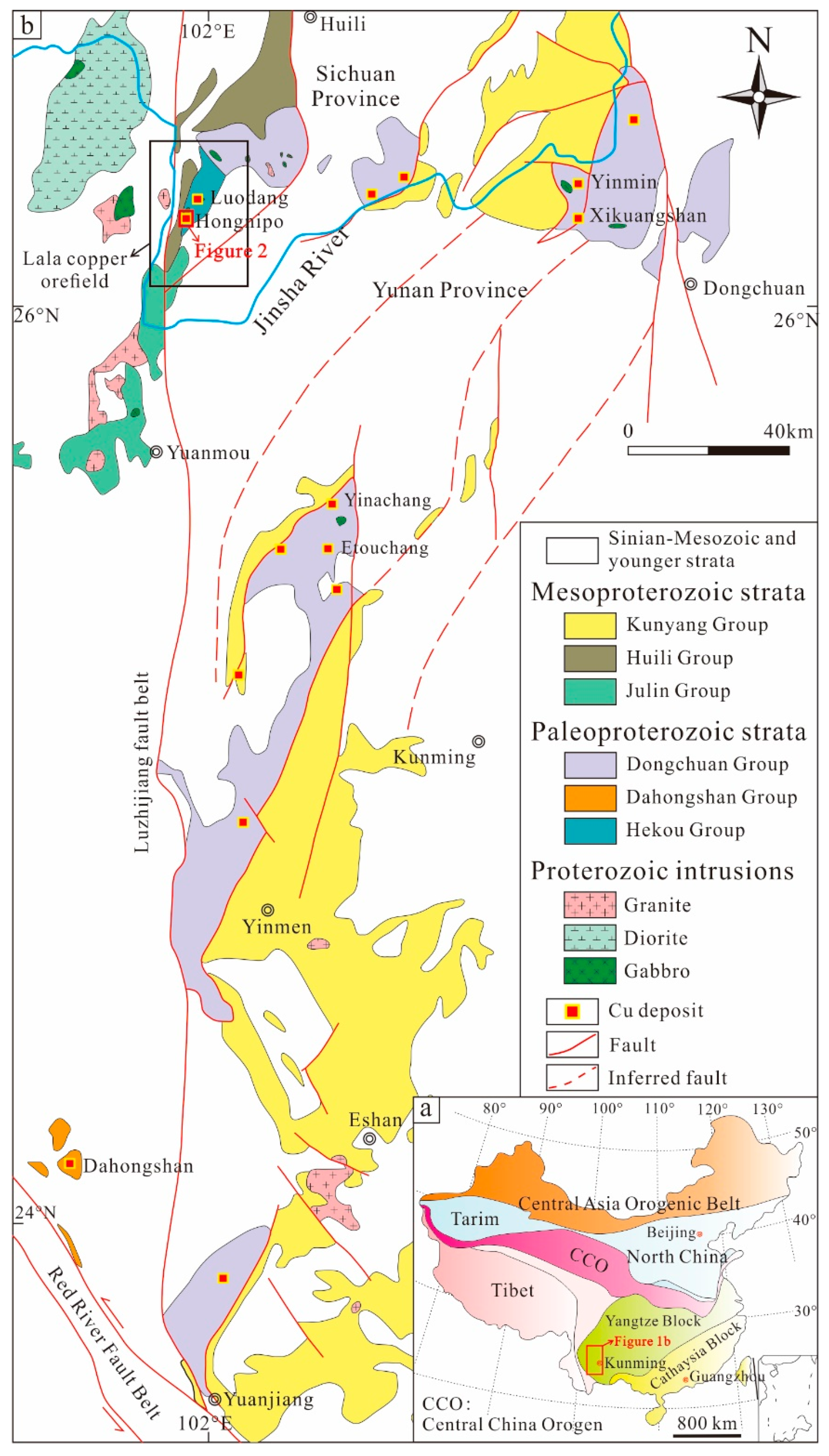

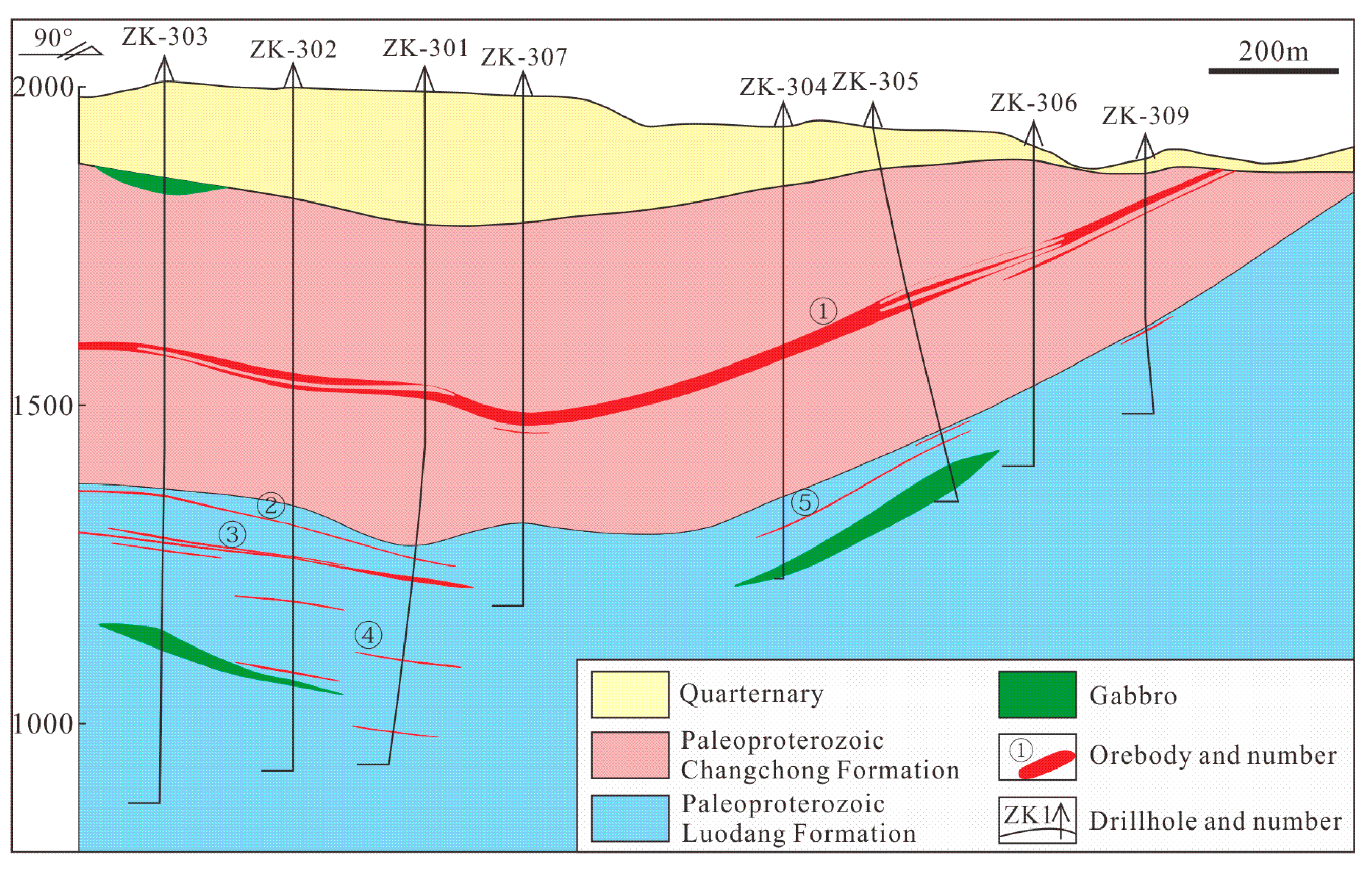

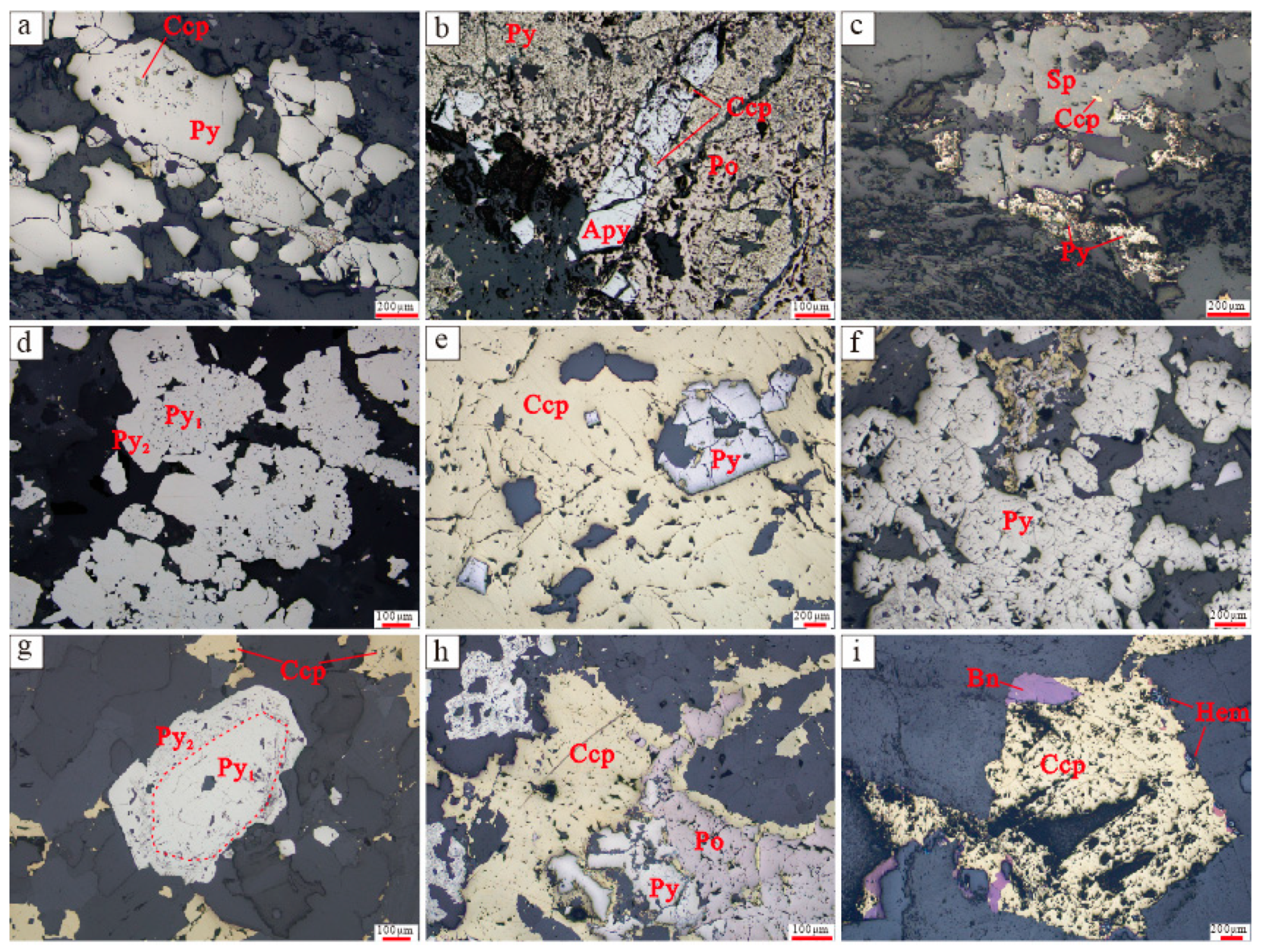
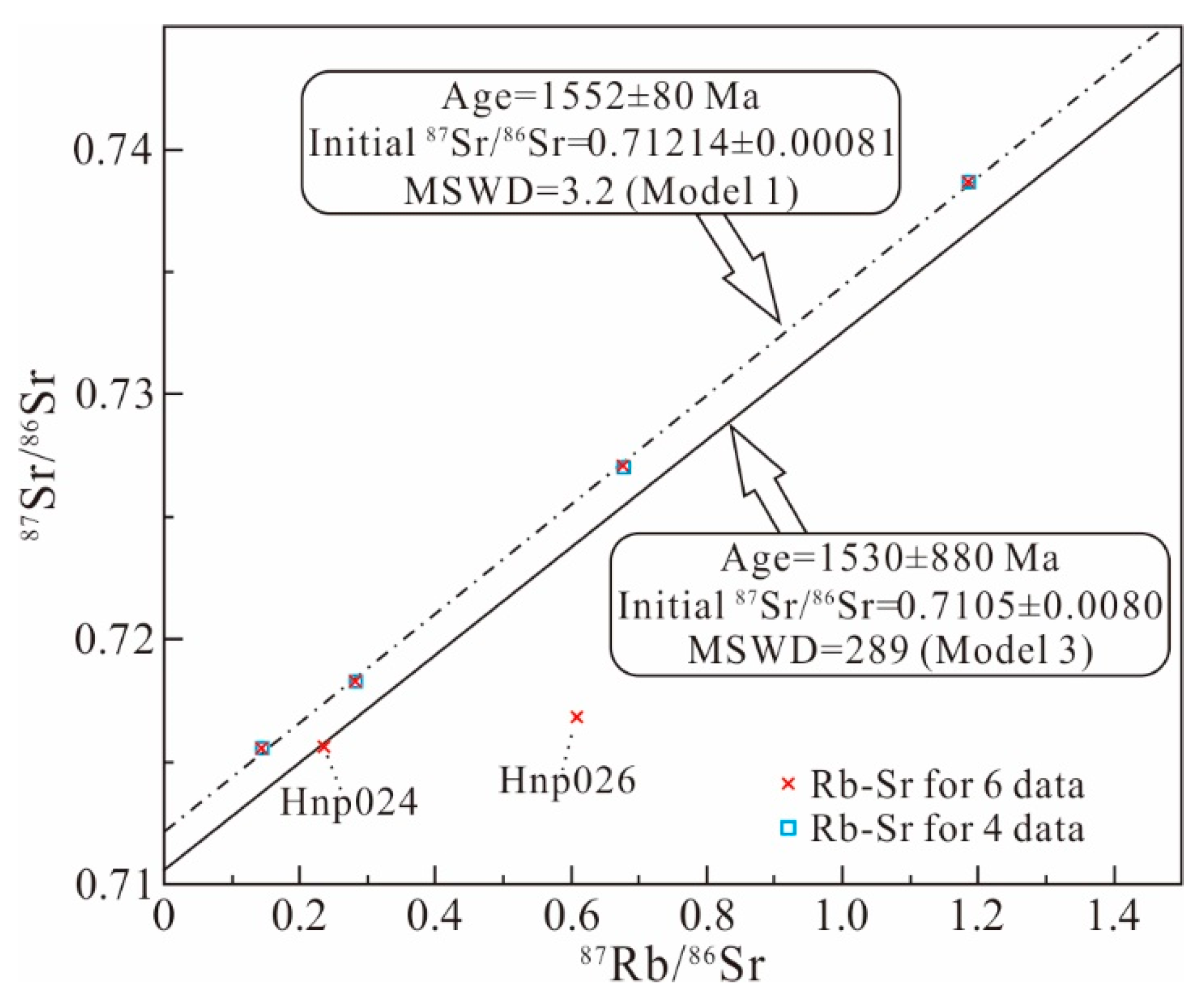
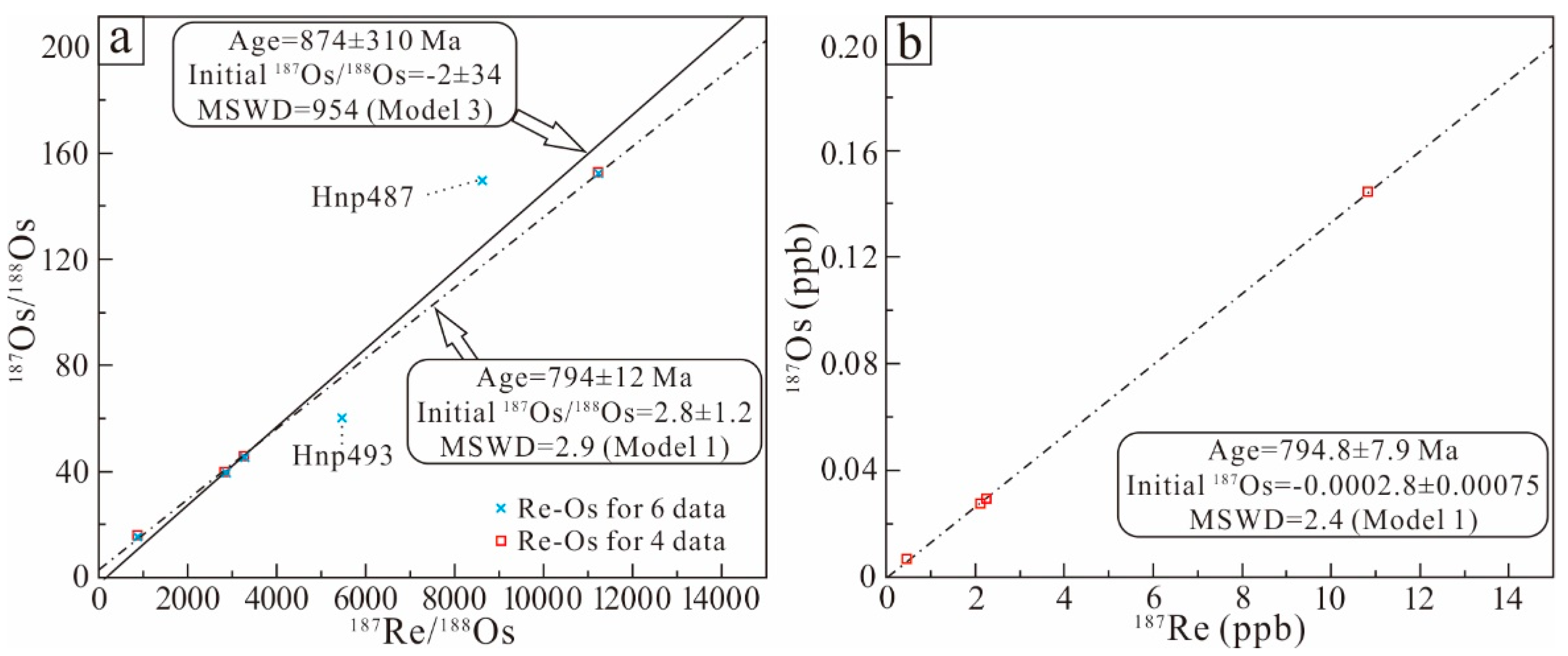
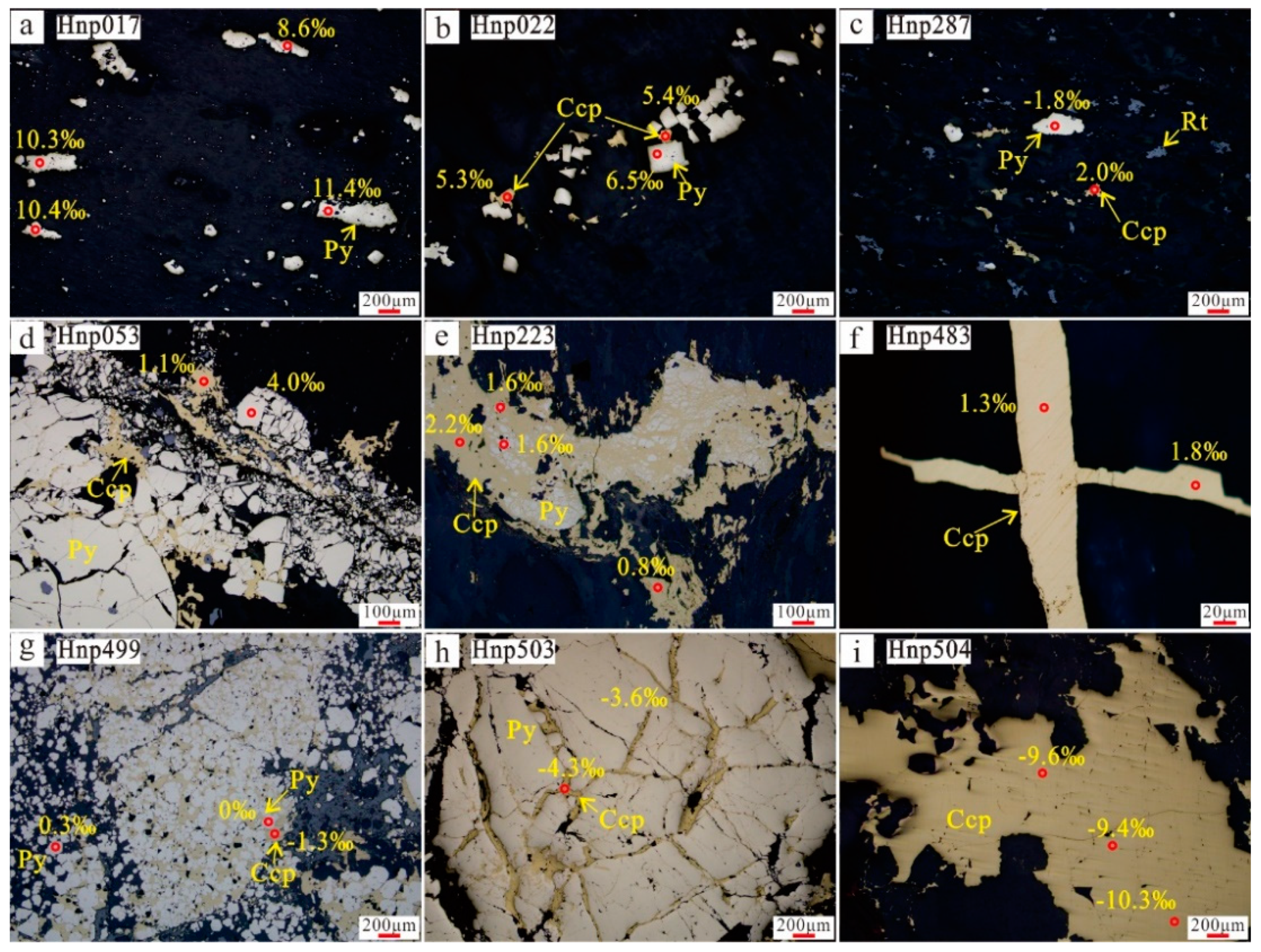

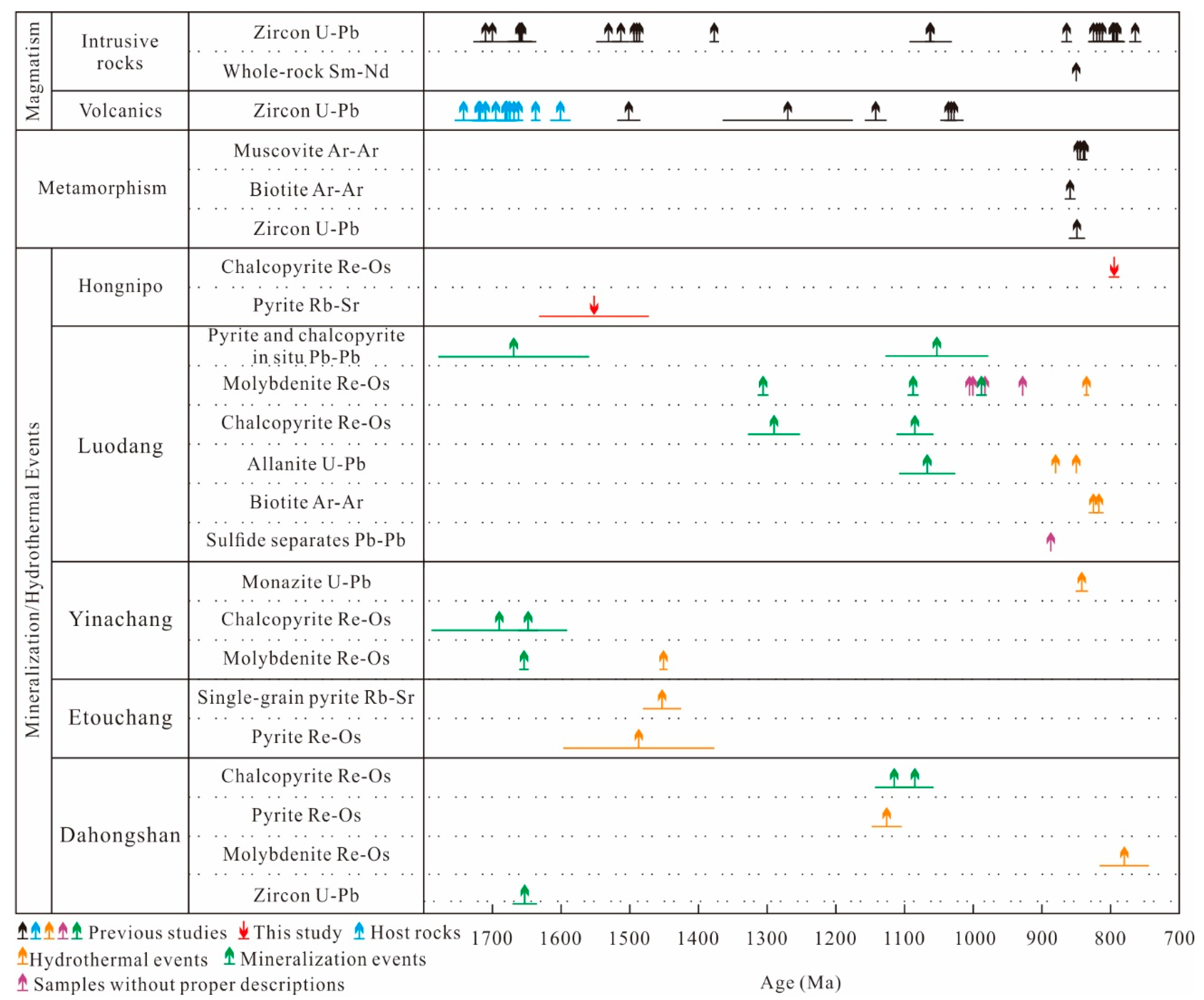
| Sample | Drill Hole | Depth (m) | Ore Type | Sample | Drill Hole | Depth (m) | Ore Type |
|---|---|---|---|---|---|---|---|
| Hnp017 | ZK−301 | 441 | Laminated | Hnp483 | ZK−459 | 256 | Vein-type |
| Hnp019 | 443 | Hnp484 | 260 | ||||
| Hnp022 | 449 | Hnp487 | 266 | ||||
| Hnp024 | 450 | Hnp488 | 267 | ||||
| Hnp026 | 453 | Hnp490 | 278 | ||||
| Hnp031 | 458 | Hnp493 | 285 | ||||
| Hnp053 | 765 | Vein-type | Hnp495 | 289 | |||
| Hnp178 | ZK−1006 | 394 | Laminated | Hnp499 | ZK−801 | 519 | Vein-type |
| Hnp181 | 399 | Hnp503 | 529 | ||||
| Hnp223 | ZK−553 | 136 | Vein-type | Hnp504 | 542 | ||
| Hnp287 | ZK−903 | 549 | Laminated |
| Sample | Rb (ppm) | Sr (ppm) | 87Rb/86Sr | 87Sr/86Sr | 2σ | (87Sr/86Sr)ia |
|---|---|---|---|---|---|---|
| Hnp019 | 0.07 | 1.41 | 0.1447 | 0.715554 | 0.000013 | 0.712330 |
| Hnp024 | 0.022 | 0.269 | 0.2374 | 0.715583 | 0.000019 | |
| Hnp026 | 0.074 | 0.353 | 0.6095 | 0.716814 | 0.000019 | |
| Hnp031 | 0.17 | 1.74 | 0.2819 | 0.718292 | 0.000021 | 0.712010 |
| Hnp178 | 0.287 | 1.04 | 0.6771 | 0.727045 | 0.000019 | 0.711957 |
| Hnp181 | 0.446 | 1.09 | 1.1854 | 0.738650 | 0.000011 | 0.712236 |
| Sample | Re (ppb) | 2σ | Total Os (ppb) | 2σ | Common Os (ppb) | 2σ | 187Re (ppb) | 2σ | 187Os (ppb) | 2σ | |||||||
| Hnp484 | 3.579 | 0.026 | 0.0374 | 0.0001 | 0.00607 | 0.00005 | 2.249 | 0.017 | 0.0315 | 0.0002 | |||||||
| Hnp487 | 5.869 | 0.043 | 0.0674 | 0.0002 | 0.00329 | 0.00003 | 3.689 | 0.027 | 0.0642 | 0.0005 | |||||||
| Hnp488 | 17.23 | 0.13 | 0.1544 | 0.0005 | 0.00742 | 0.00006 | 10.83 | 0.080 | 0.1471 | 0.0011 | |||||||
| Hnp490 | 3.373 | 0.025 | 0.0342 | 0.0001 | 0.00495 | 0.00004 | 2.119 | 0.016 | 0.0294 | 0.0002 | |||||||
| Hnp493 | 5.156 | 0.038 | 0.0403 | 0.0001 | 0.00455 | 0.00004 | 3.241 | 0.024 | 0.0358 | 0.0003 | |||||||
| Hnp495 | 0.7317 | 0.0054 | 0.0123 | 0.0001 | 0.00404 | 0.00004 | 0.4598 | 0.0034 | 0.0083 | 0.0001 | |||||||
| Sample | 187Re/188Os | 2σ | 187Os/188Os | 2σ | 187Osr a (ppb) | 2σ b | %187Os c | Model Age (Ma) d | 2σ e | ||||||||
| Hnp484 | 2845 | 30 | 39.8 | 0.10 | 0.0292 | 0.00074 | 92.82 | 774 | 17 | ||||||||
| Hnp487 | 8612 | 91 | 149.7 | 0.5 | |||||||||||||
| Hnp488 | 11225 | 118 | 152.5 | 0.36 | 0.1444 | 0.00008 | 98.12 | 795 | 22 | ||||||||
| Hnp490 | 3288 | 35 | 45.58 | 0.17 | 0.0275 | 0.00058 | 93.73 | 775 | 19 | ||||||||
| Hnp493 | 5473 | 59 | 60.58 | 0.24 | |||||||||||||
| Hnp495 | 873.8 | 11.3 | 15.82 | 0.13 | 0.0068 | 0.00060 | 81.95 | ||||||||||
| Ore Type | Sample | Spot | Mineral | δ34S |
|---|---|---|---|---|
| Lamellar | Hnp017 | 1 | Pyrite | −1.8 |
| 2 | Chalcopyrite | 2.0 | ||
| Hnp022 | 1 | Pyrite | 6.5 | |
| 2 | Chalcopyrite | 5.3 | ||
| 3 | Chalcopyrite | 5.4 | ||
| Hnp287 | 1 | Pyrite | 10.3 | |
| 2 | Pyrite | 10.4 | ||
| 3 | Pyrite | 8.6 | ||
| 4 | Pyrite | 11.4 | ||
| Vein-type | Hnp053 | 1 | Pyrite | 4.0 |
| 2 | Chalcopyrite | 1.1 | ||
| Hnp223 | 1 | Pyrite | 1.6 | |
| 2 | Pyrite | 1.6 | ||
| 3 | Chalcopyrite | 2.2 | ||
| 4 | Chalcopyrite | 0.8 | ||
| Hnp483 | 1 | Chalcopyrite | 1.3 | |
| 2 | Chalcopyrite | 1.8 | ||
| Hnp499 | 1 | Pyrite | 0.3 | |
| 2 | Pyrite | 0 | ||
| 3 | Chalcopyrite | -1.3 | ||
| Hnp503 | 1 | Pyrite | −3.6 | |
| 2 | Chalcopyrite | −4.3 | ||
| Hnp504 | 1 | Chalcopyrite | −9.6 | |
| 2 | Chalcopyrite | −9.4 | ||
| 3 | Chalcopyrite | −10.3 |
© 2020 by the authors. Licensee MDPI, Basel, Switzerland. This article is an open access article distributed under the terms and conditions of the Creative Commons Attribution (CC BY) license (http://creativecommons.org/licenses/by/4.0/).
Share and Cite
Lin, L.; Chen, R.; Pang, Z.; Chen, H.; Xue, J.; Jia, H. Sulfide Rb-Sr, Re-Os and In Situ S Isotopic Constraints on Two Mineralization Events at the Large Hongnipo Cu Deposit, SW China. Minerals 2020, 10, 414. https://doi.org/10.3390/min10050414
Lin L, Chen R, Pang Z, Chen H, Xue J, Jia H. Sulfide Rb-Sr, Re-Os and In Situ S Isotopic Constraints on Two Mineralization Events at the Large Hongnipo Cu Deposit, SW China. Minerals. 2020; 10(5):414. https://doi.org/10.3390/min10050414
Chicago/Turabian StyleLin, Lujun, Renyi Chen, Zhenshan Pang, Hui Chen, Jianling Xue, and Hongxiang Jia. 2020. "Sulfide Rb-Sr, Re-Os and In Situ S Isotopic Constraints on Two Mineralization Events at the Large Hongnipo Cu Deposit, SW China" Minerals 10, no. 5: 414. https://doi.org/10.3390/min10050414
APA StyleLin, L., Chen, R., Pang, Z., Chen, H., Xue, J., & Jia, H. (2020). Sulfide Rb-Sr, Re-Os and In Situ S Isotopic Constraints on Two Mineralization Events at the Large Hongnipo Cu Deposit, SW China. Minerals, 10(5), 414. https://doi.org/10.3390/min10050414




